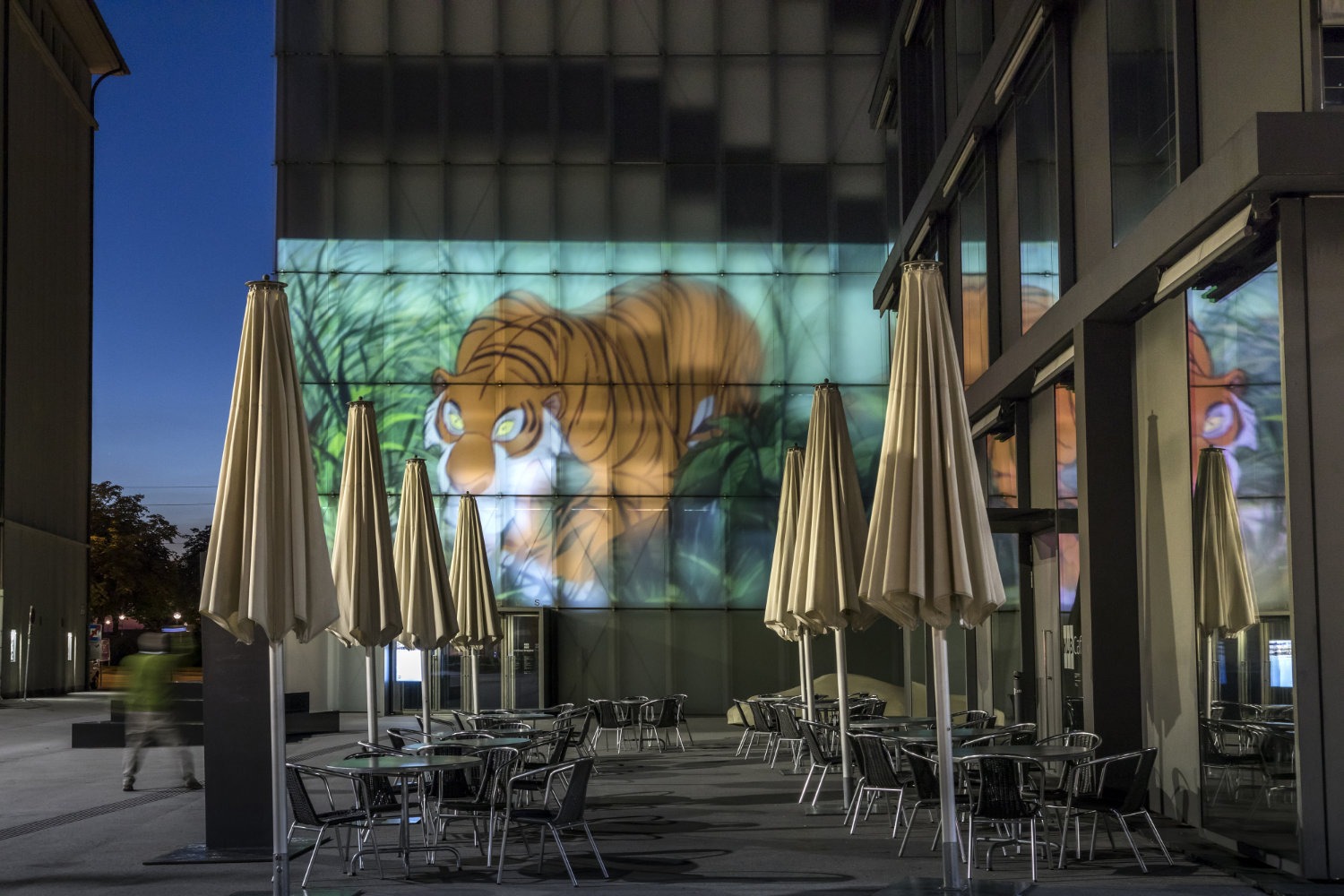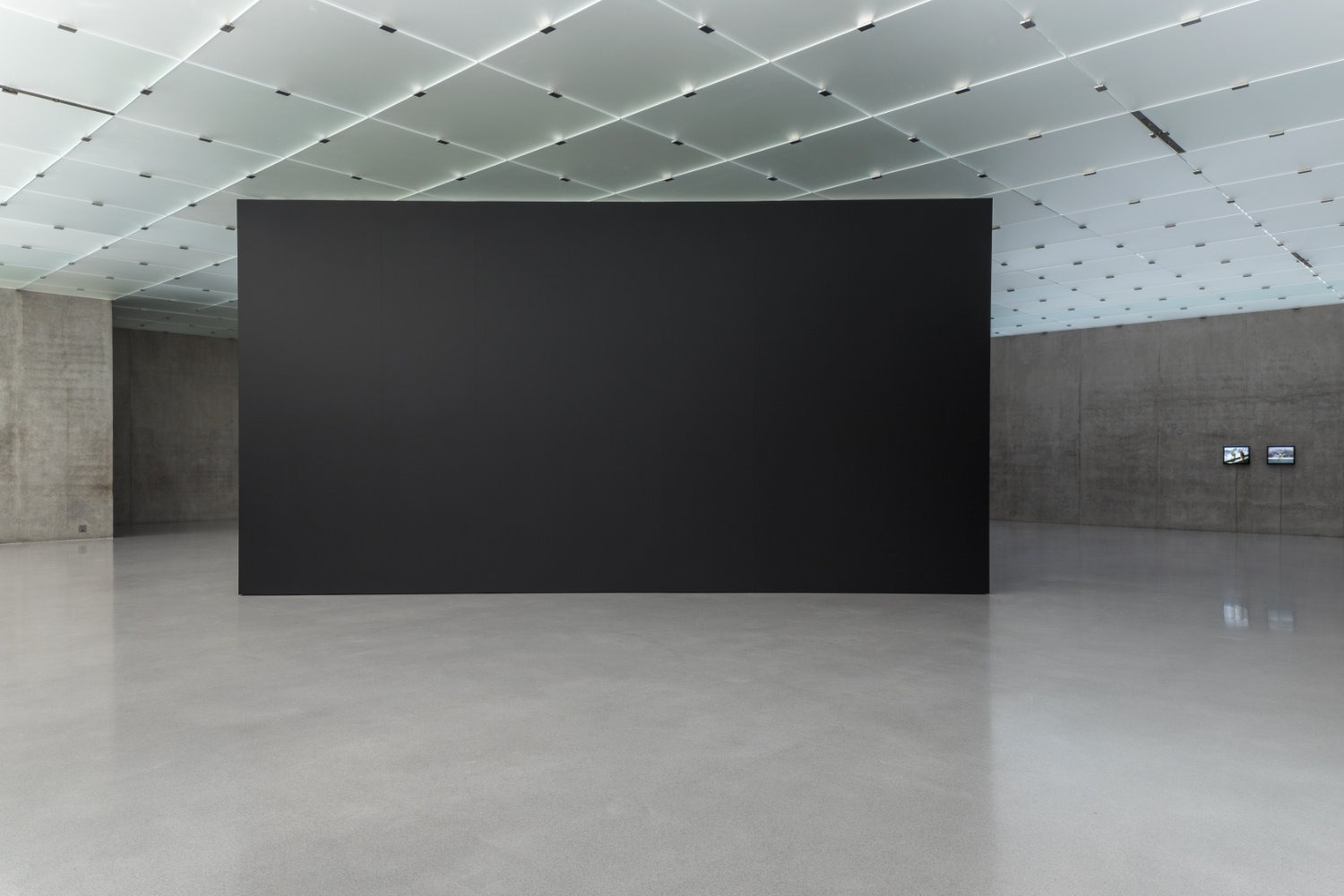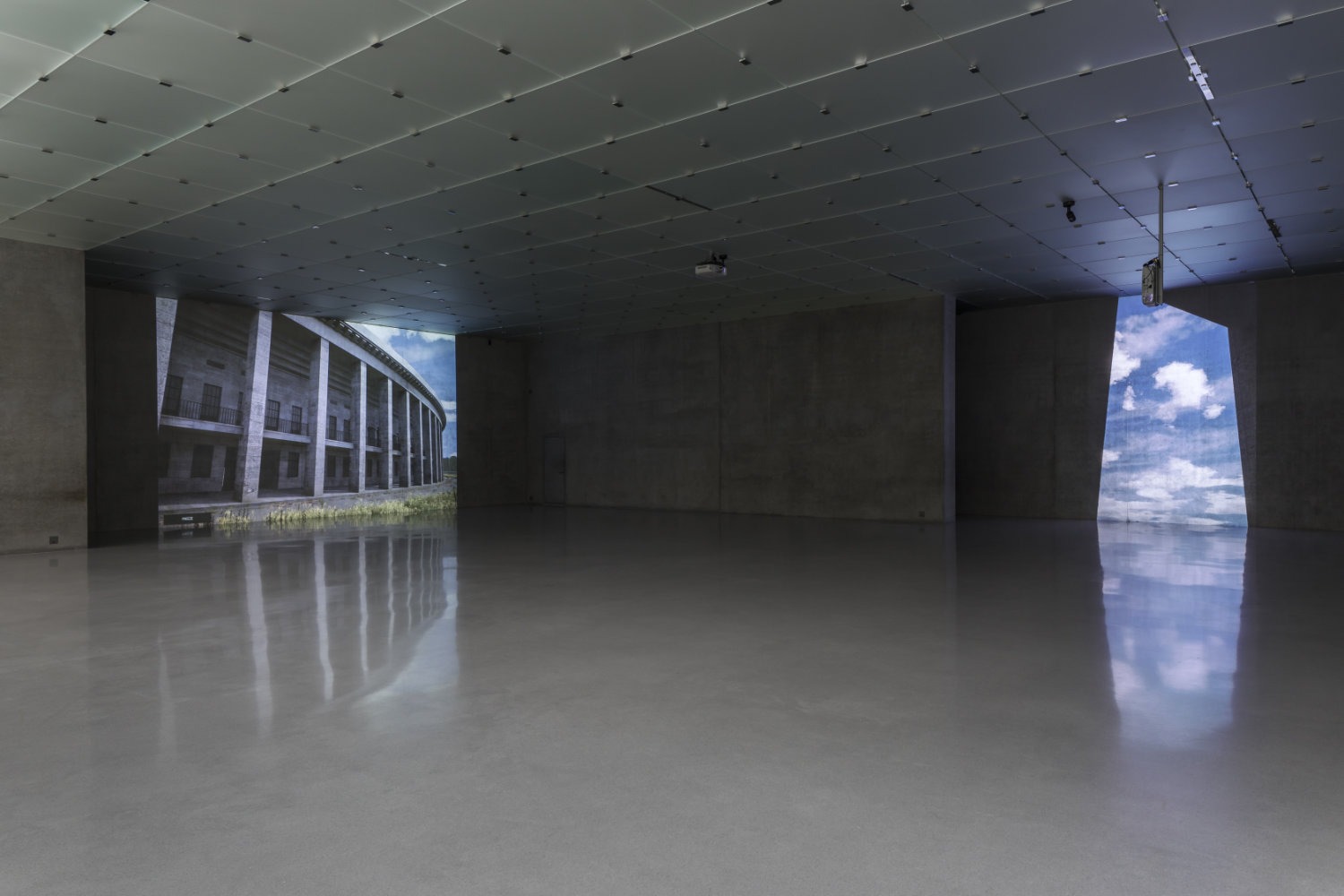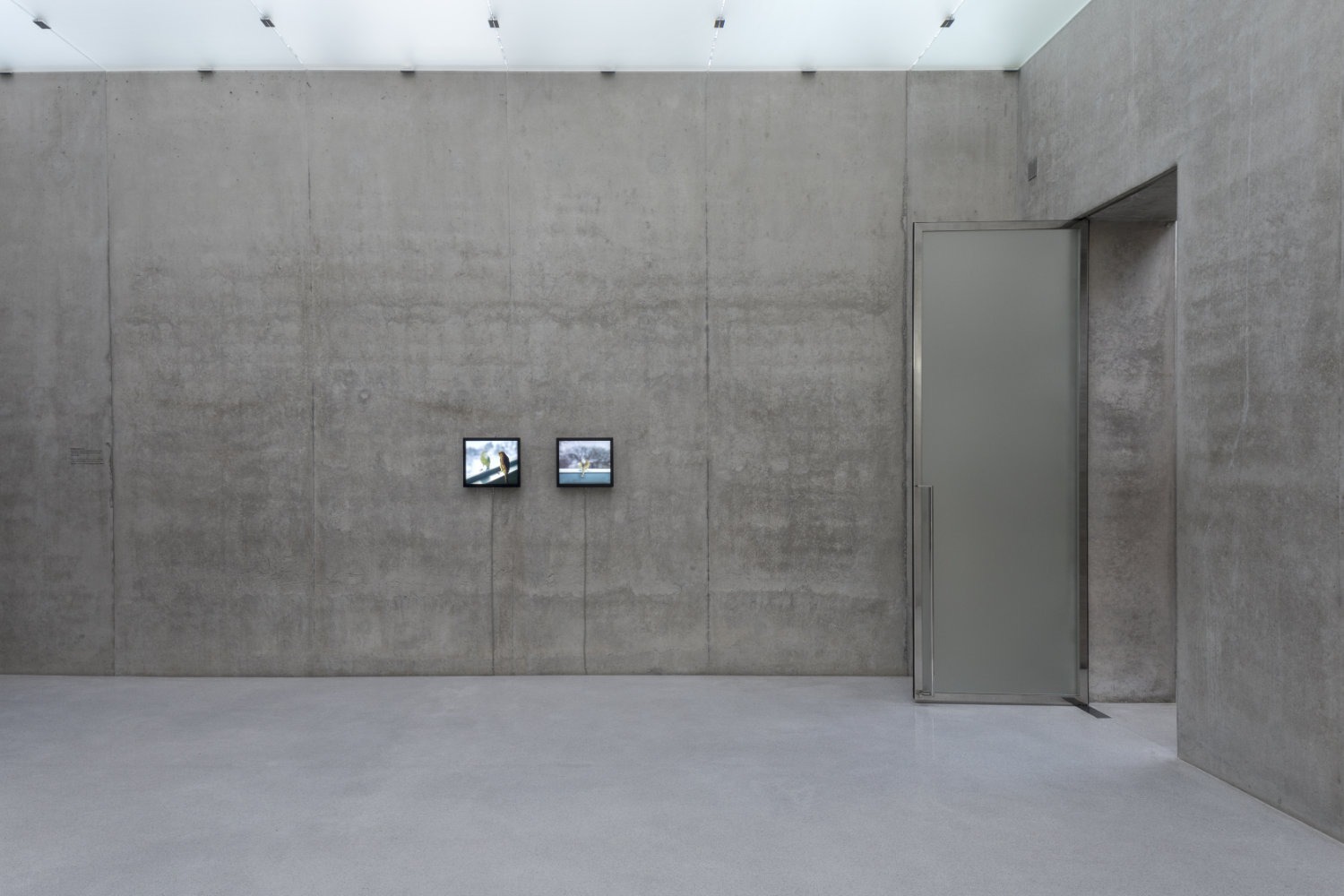David Claerbout
14 Jul - 07 Oct 2018

David Claerbout
Die reine Notwendigkeit / The Pure Necessity, 2016
Installation view Facade Kunsthaus Bregenz, 2018
Photo: Markus Tretter
Courtesy of David Claerbout
© David Claerbout, Kunsthaus Bregenz
Die reine Notwendigkeit / The Pure Necessity, 2016
Installation view Facade Kunsthaus Bregenz, 2018
Photo: Markus Tretter
Courtesy of David Claerbout
© David Claerbout, Kunsthaus Bregenz

David Claerbout
Die reine Notwendigkeit / The Pure Necessity, 2016
Installation view Facade Kunsthaus Bregenz, 2018
Photo: Markus Tretter
Courtesy of David Claerbout
© David Claerbout, Kunsthaus Bregenz
Die reine Notwendigkeit / The Pure Necessity, 2016
Installation view Facade Kunsthaus Bregenz, 2018
Photo: Markus Tretter
Courtesy of David Claerbout
© David Claerbout, Kunsthaus Bregenz

David Claerbout
Installation view first floor, Kunsthaus Bregenz
Photo: Markus Tretter
Courtesy of David Claerbout
© David Claerbout, Kunsthaus Bregenz
Installation view first floor, Kunsthaus Bregenz
Photo: Markus Tretter
Courtesy of David Claerbout
© David Claerbout, Kunsthaus Bregenz

David Claerbout
Installation view first floor, Kunsthaus Bregenz
Photo: Markus Tretter
Courtesy of David Claerbout
© David Claerbout, Kunsthaus Bregenz
Installation view first floor, Kunsthaus Bregenz
Photo: Markus Tretter
Courtesy of David Claerbout
© David Claerbout, Kunsthaus Bregenz

David Claerbout
Olympia (The Real-Time Disintegration into Ruins of the Berlin Olympic Stadium over the Course of a Thousand Years), 2016-3016
Installation view third floor, Kunsthaus Bregenz
Photo: Markus Tretter
Courtesy David Claerbout, Sean Kelly, New York, Galerie Rüdiger Schöttle, München, untilthen, Paris, und Esther Schipper, Berlin
© David Claerbout, Kunsthaus Bregenz
Olympia (The Real-Time Disintegration into Ruins of the Berlin Olympic Stadium over the Course of a Thousand Years), 2016-3016
Installation view third floor, Kunsthaus Bregenz
Photo: Markus Tretter
Courtesy David Claerbout, Sean Kelly, New York, Galerie Rüdiger Schöttle, München, untilthen, Paris, und Esther Schipper, Berlin
© David Claerbout, Kunsthaus Bregenz

David Claerbout
Radio Piece (Hong Kong), 2015
Installation view first floor, Kunsthaus Bregenz
Photo: Markus Tretter
In collaboration with RAY Fotografieprojekte Frankfurt / Rhein-Main
Courtesy David Claerbout, Sean Kelly, New York, Galerie Rüdiger Schöttle, München, untilthen, Paris, and Esther Schipper, Berlin
© David Claerbout, Kunsthaus Bregenz
Radio Piece (Hong Kong), 2015
Installation view first floor, Kunsthaus Bregenz
Photo: Markus Tretter
In collaboration with RAY Fotografieprojekte Frankfurt / Rhein-Main
Courtesy David Claerbout, Sean Kelly, New York, Galerie Rüdiger Schöttle, München, untilthen, Paris, and Esther Schipper, Berlin
© David Claerbout, Kunsthaus Bregenz

David Claerbout
The Quiet Shore, 2011
Installation view ground floor, Kunsthaus Bregenz
Photo: Markus Tretter
Courtesy David Claerbout, Sean Kelly, New York, Galerie Rüdiger Schöttle, München, untilthen, Paris, und Esther Schipper, Berlin
© David Claerbout, Kunsthaus Bregenz
The Quiet Shore, 2011
Installation view ground floor, Kunsthaus Bregenz
Photo: Markus Tretter
Courtesy David Claerbout, Sean Kelly, New York, Galerie Rüdiger Schöttle, München, untilthen, Paris, und Esther Schipper, Berlin
© David Claerbout, Kunsthaus Bregenz

David Claerbout
Breathing Bird, 2012
Installation view first floor, Kunsthaus Bregenz
Photo: Markus Tretter
Courtesy David Claerbout, Sean Kelly, New York, Galerie Rüdiger Schöttle, München, untilthen, Paris, and Esther Schipper, Berlin
© David Claerbout, Kunsthaus Bregenz
Breathing Bird, 2012
Installation view first floor, Kunsthaus Bregenz
Photo: Markus Tretter
Courtesy David Claerbout, Sean Kelly, New York, Galerie Rüdiger Schöttle, München, untilthen, Paris, and Esther Schipper, Berlin
© David Claerbout, Kunsthaus Bregenz

David Claerbout
Olympia (The Real-Time Disintegration into Ruins of the Berlin Olympic Stadium over the Course of a Thousand Years), 2016-3016
Installation view third floor, Kunsthaus Bregenz
Photo: Markus Tretter
Courtesy David Claerbout, Sean Kelly, New York, Galerie Rüdiger Schöttle, München, untilthen, Paris, und Esther Schipper, Berlin
© David Claerbout, Kunsthaus Bregenz
Olympia (The Real-Time Disintegration into Ruins of the Berlin Olympic Stadium over the Course of a Thousand Years), 2016-3016
Installation view third floor, Kunsthaus Bregenz
Photo: Markus Tretter
Courtesy David Claerbout, Sean Kelly, New York, Galerie Rüdiger Schöttle, München, untilthen, Paris, und Esther Schipper, Berlin
© David Claerbout, Kunsthaus Bregenz

David Claerbout
Olympia (The Real-Time Disintegration into Ruins of the Berlin Olympic Stadium over the Course of a Thousand Years), 2016 – 3016
Two channel real-time projection, HD animation, silent, 1000 years, screenshot
With support from VAF Vlaams Audiovisueel Fonds
Courtesy David Claerbout, Sean Kelly, New York, Galerie Rüdiger Schöttle, München, untilthen, Paris, and Esther Schipper, Berlin
© David Claerbout | Bildrecht, Wien, 2018
Olympia (The Real-Time Disintegration into Ruins of the Berlin Olympic Stadium over the Course of a Thousand Years), 2016 – 3016
Two channel real-time projection, HD animation, silent, 1000 years, screenshot
With support from VAF Vlaams Audiovisueel Fonds
Courtesy David Claerbout, Sean Kelly, New York, Galerie Rüdiger Schöttle, München, untilthen, Paris, and Esther Schipper, Berlin
© David Claerbout | Bildrecht, Wien, 2018
DAVID CLAERBOUT
14 July — 7 October 2018
For its 2018 summer exhibition, Kunsthaus Bregenz is presenting David Claerbout, one of today’s leading contemporary artists. From July 14 to October 7 the artist based in Antwerp and Berlin is showing video and sound works at Kunsthaus Bregenz.
Visitors coming into the entrance hall of the Kunsthaus Bregenz this summer will face a large screen. A sequence of images fades into the soft ambient light of Peter Zumthor’s famous building. The video work The Quiet Shore, 2011, seems as if it were made for this place. It is a work by David Claerbout, one of the most renowned and significant contemporary artists. This year’s summer exhibition at the Kunsthaus Bregenz focuses on his video and sound works.
In Travel, 1996–2013, presented on the first floor, the viewer is taken on a visual tour through a forst inspired by relaxation music. The dispassionate yet cinematic character of the synthesizer, suggestive of “generic” images that anyone could imagine, of places in a dark and tranquil forest, prompted the decision not to film, but to use advanced computer-generated images. This choice reflects the search for a space that is beyond the specific, that wants to be generic like the music.
Radio Piece (Hong Kong), 2015, is an audio-visual installation on the second floor that deals with the intersection of mental and physical space, set in the “walled city,” a vertical slum in the Kowloon district of Hong Kong. Radio Piece casts doubt on the coherence of perception, while formulating a critique of the colonization of the mind as real estate.
Claerbout’s newest video Olympia (The Real-Time Disintegration into Ruins of the Berlin Olympic Stadium over the Course of a Thousand Years), 2016—3016, on the top floor of the KUB is a digital reconstruction of the Olympic Stadium in Berlin, which was built by the Nazis and opened for the 1936 Summer Olympics with great pomp. David Claerbout scanned each stone to create a deceptively real 3D version. The camera leads up to the empty building and through its monumental halls. Its representation in real time has been calculated to last for a thousand years. Stones erode and plants sprout. Even the current weather conditions are simulated using data from a webcam: if the sky over Berlin is cloudless, so it is in the projection.
David Claerbout’s art follows the fascination with the cycles of nature and the ideas of care and time. His works require sensitivity to light and shading, distance and focus, rest and the passage of time. They are characterized by sequences of images without cuts. In fact, the impressions are created digitally. All the shots are based on complex computer calculations. No image is seen; they are all constructed.
In the evening, when the exhibition closes, the facade of the KUB comes to life with an outdoor projection of Claerbout’s Die reine Notwendigkeit/The Pure Necessity (2016). The video is based on the classic 1967 film The Jungle Book. In Claerbout’s film, Baloo, Bagheera, and Kaa do not sing, talk, and dance; Claerbout shows a bear, a panther, and a snake as they behave in nature. They are no longer anthropomorphized. Unlike his other films, these shots were not digitally rendered. Instead, each frame was drawn by hand in the style of the original animated film.
David Claerbout (born 1969 in Kortrijk, Belgium) studied painting in Antwerp. He lives and works in Antwerp and Berlin.
He has been the subject of numerous solo exhibitions internationally at venues including the Van Abbemuseum, Eindhoven (2005), Centre Pompidou, Paris (2007), Kunstmuseum St. Gallen (2008), Museum De Pont, Tilburg (2009 and 2016), WIELS, Brussels (2011), SFMOMA — San Francisco Museum of Modern Art (2011), Tel Aviv Museum of Art (2012), Wiener Secession (2012), Kunsthalle Mainz (2013), Nederlands Fotomuseum, Rotterdam (2014), Marabouparken Konsthall, Sundbyberg (2015), KINDL – Centre for Contemporary Art, Berlin (2016), Städel Museum, Frankfurt / Main (2016), MNAC — Museu Nacional d’Art de Catalunya, Barcelona (2017), as well as Schaulager, Münchenstein / Basel (2017). His work is represented in major public collections worldwide.
14 July — 7 October 2018
For its 2018 summer exhibition, Kunsthaus Bregenz is presenting David Claerbout, one of today’s leading contemporary artists. From July 14 to October 7 the artist based in Antwerp and Berlin is showing video and sound works at Kunsthaus Bregenz.
Visitors coming into the entrance hall of the Kunsthaus Bregenz this summer will face a large screen. A sequence of images fades into the soft ambient light of Peter Zumthor’s famous building. The video work The Quiet Shore, 2011, seems as if it were made for this place. It is a work by David Claerbout, one of the most renowned and significant contemporary artists. This year’s summer exhibition at the Kunsthaus Bregenz focuses on his video and sound works.
In Travel, 1996–2013, presented on the first floor, the viewer is taken on a visual tour through a forst inspired by relaxation music. The dispassionate yet cinematic character of the synthesizer, suggestive of “generic” images that anyone could imagine, of places in a dark and tranquil forest, prompted the decision not to film, but to use advanced computer-generated images. This choice reflects the search for a space that is beyond the specific, that wants to be generic like the music.
Radio Piece (Hong Kong), 2015, is an audio-visual installation on the second floor that deals with the intersection of mental and physical space, set in the “walled city,” a vertical slum in the Kowloon district of Hong Kong. Radio Piece casts doubt on the coherence of perception, while formulating a critique of the colonization of the mind as real estate.
Claerbout’s newest video Olympia (The Real-Time Disintegration into Ruins of the Berlin Olympic Stadium over the Course of a Thousand Years), 2016—3016, on the top floor of the KUB is a digital reconstruction of the Olympic Stadium in Berlin, which was built by the Nazis and opened for the 1936 Summer Olympics with great pomp. David Claerbout scanned each stone to create a deceptively real 3D version. The camera leads up to the empty building and through its monumental halls. Its representation in real time has been calculated to last for a thousand years. Stones erode and plants sprout. Even the current weather conditions are simulated using data from a webcam: if the sky over Berlin is cloudless, so it is in the projection.
David Claerbout’s art follows the fascination with the cycles of nature and the ideas of care and time. His works require sensitivity to light and shading, distance and focus, rest and the passage of time. They are characterized by sequences of images without cuts. In fact, the impressions are created digitally. All the shots are based on complex computer calculations. No image is seen; they are all constructed.
In the evening, when the exhibition closes, the facade of the KUB comes to life with an outdoor projection of Claerbout’s Die reine Notwendigkeit/The Pure Necessity (2016). The video is based on the classic 1967 film The Jungle Book. In Claerbout’s film, Baloo, Bagheera, and Kaa do not sing, talk, and dance; Claerbout shows a bear, a panther, and a snake as they behave in nature. They are no longer anthropomorphized. Unlike his other films, these shots were not digitally rendered. Instead, each frame was drawn by hand in the style of the original animated film.
David Claerbout (born 1969 in Kortrijk, Belgium) studied painting in Antwerp. He lives and works in Antwerp and Berlin.
He has been the subject of numerous solo exhibitions internationally at venues including the Van Abbemuseum, Eindhoven (2005), Centre Pompidou, Paris (2007), Kunstmuseum St. Gallen (2008), Museum De Pont, Tilburg (2009 and 2016), WIELS, Brussels (2011), SFMOMA — San Francisco Museum of Modern Art (2011), Tel Aviv Museum of Art (2012), Wiener Secession (2012), Kunsthalle Mainz (2013), Nederlands Fotomuseum, Rotterdam (2014), Marabouparken Konsthall, Sundbyberg (2015), KINDL – Centre for Contemporary Art, Berlin (2016), Städel Museum, Frankfurt / Main (2016), MNAC — Museu Nacional d’Art de Catalunya, Barcelona (2017), as well as Schaulager, Münchenstein / Basel (2017). His work is represented in major public collections worldwide.
